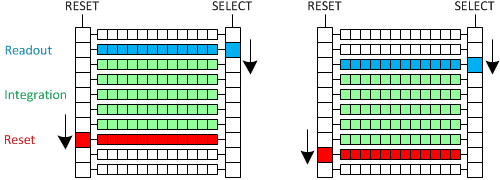|
BigCam |
|
The sensor used in BigCam is IBIS4-14000C - a 14-megapixel, Bayer mosaic, 3T CMOS sensor. It has been designed by FillFactory. FillFactory has later been acquired by Cypress, and then ON Semi, with at least a few of their key people leaving to found CMOSIS in the end; unfortunately, in the process, the sensor has been discontinued in 2011. The parts do however pop up on eBay, usually as Kodak DCS/14n image sensors, at amazingly good prices. For the time being, ON Semi still has a product page for the monochrome variant of the sensor. The resolution of the sensor is 4536x3024 active pixels, with pixel pitch of 8um (square pixels). This means the imaging area is about 36x24mm, similar to a standard frame of 35mm photographic film. IBIS4-14000 was one of the first CMOS sensors of that size, and so a pretty remarkable product at the time. Its noise characteristics (SNR of 65.4dB, according to the datasheet) are not quite as good as sensors from big-name DSLRs (technology has certainly moved forward), but the part remains a well-documented and extremely flexible chip. The pixel architecture is a classic 3T pixel. This means there is no global electronic shutter. This choice was probably dictated by the target application (DSLR cameras) not requiring one - DSLR cameras have a mechanical focal plane shutter, and a sensor production yield & fill factor tradeoff that comes with a more complex pixel.
Instead, the sensor features a rolling shutter scheme, where a reset line is moved through the pixel array ahead of a readout line. The time between those two lines moving over a given pixel determines the integration time of the pixel (the time during which pixel gathers photoelectrons). The downside of this scheme is that the readout line has to move comparatively slowly; so while the integration time can be extremely short, the whole scene is exposed for about 300ms. Moving objects will produce artifacts.
The 300ms time results from the limitation on output bandwidth of the sensor. There are 4 outputs, each of which can read at most 15M samples per second - simple calculation shows that reading out all 14M pixels takes about 250ms. Some additional time is required by other control signals that need to be sent to the sensor (for instance, to select a new row to read out). The sensor features a number of sub-sampling modes, where not all pixels are read out, and the frame rate in those modes improves - a 1134x756 image can be read at 13fps, and a 567x378 at 41fps. Those modes are useful for image preview. It is also possible to window the sensor in the Y direction, by reading only a subset of rows. |
(c) 2011 Stanislaw Skowronek
Contact me: skylark unaligned org (figure out where to put the @ and .)


